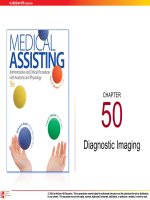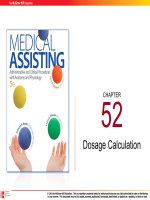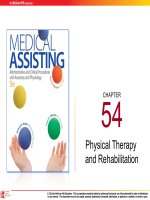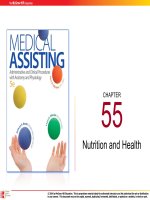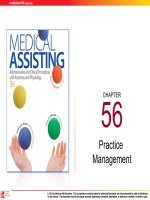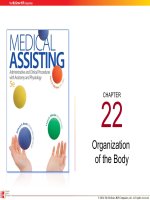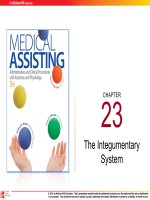Medical assisting Administrative and clinical procedures (5e) Chapter 33 The digestive system
Bạn đang xem bản rút gọn của tài liệu. Xem và tải ngay bản đầy đủ của tài liệu tại đây (1.02 MB, 51 trang )
CHAPTER
33
The Digestive
System
33-2
Learning Outcomes (cont.)
33.1 Describe the organs of the alimentary
canal and their functions.
33.2 Explain the functions of the digestive
system’s accessory organs.
33-3
Learning Outcomes (cont.)
33.3 Identify the nutrients absorbed by the
digestive system and where they are
absorbed.
33.4 Describe the causes, signs and
symptoms, and treatments of various
common diseases and disorders of the
digestive system.
33-4
Introduction
• Digestion – mechanical and
chemical breakdown of
foods
• Organs of digestion
– Alimentary canal organs form a
pathway extending from the mouth
to the anus
– Accessory organs
33-5
Characteristics of the Alimentary Canal
• Mucosa
– Epithelial tissue
– Secretes enzymes and mucus
– Absorbs nutrients
• Submucosa – loose connective tissue,
blood vessels, glands, and nerves
33-6
Characteristics of the Alimentary Canal
• Muscular layer
– Smooth muscle
– Contracts to move materials through the canal
• Serosa or peritoneum
– Visceral peritoneum
– Parietal peritoneum
33-7
Characteristics of the Alimentary Canal
(cont.)
•
Movements
– Churning ~ mixes substances
– Peristalsis ~ moves substances
33-8
The Mouth
• Buccal cavity
• Mechanical digestion
• Starts chemical digestion
• Cheeks – hold food in mouth
• Lips – judge temperature of food
The Mouth
33-9
The Mouth (cont.)
• Tongue
– Mixes and holds food
between teeth
– Contains taste buds
– Lingual frenulum
– Lingual tonsils
• Palate
– Hard palate
– Soft palate
– Uvula
• Lymphatic tissue
– Palatine tonsils
– Pharyngeal tonsils or
adenoids
The Mouth
33-11
The Mouth (cont.)
• Salivary glands
– Cells
• Serous – watery fluid
and amylase
• Mucous
– Parotid gland
– Submandibular gland
– Sublingual gland
33-12
The Mouth (cont.)
• Teeth – decrease size
of food particles
– Incisors
– Cuspids or canines
– Bicuspids and molars
33-13
Pharynx
• Functions
– Connects nasal
cavity with oral
cavity for breathing
• Divisions
– Nasopharynx
– Oropharynx
– Laryngopharynx
– Pushes food into
esophagus
Pharynx
33-14
Pharynx (cont.)
Swallowing
1.
Soft palate rises; uvula covers opening between
nasal and oral cavity
2.
Epiglottis covers larynx – keeps food out
3.
Tongue presses against roof of mouth, forcing food
into oropharynx
Pharynx
33-15
Pharynx (cont.)
Swallowing
4.
Muscles in pharynx contract – forcing food toward
esophagus
5.
Esophagus opens
6.
Muscles of pharynx push food through cardiac
sphincter
Pharynx
33-17
The Esophagus
• Connects pharynx to stomach
• Esophageal hiatus
• Cardiac sphincter
– Circular band of muscle
– Controls movement of food into stomach
Upper
Esophagus
Lower
Esophagus
33-18
The Stomach
• Rugae – folds of the
inner lining
• Absorbs
– Alcohol
– Water
– Some fat-soluble drugs
• Functions
– Receives food
– Mixes bolus with gastric juices chyme
– Starts protein digestion
– Moves food into small intestine
Stomach
33-19
The Stomach
• Sections
– Cardiac region
– Body
– Fundus
– Pylorus
• Pyloric sphincter – controls movement
into the small intestine
Stomach
33-20
The Stomach
• Lining – gastric glands
– Cells ~ mucous, chief, and parietal
– Stimulated by
• Parasympathetic nervous system
• Gastrin – made by the stomach
– Inhibited by cholecystokinin (CCK) made by the small
intestine
Stomach
33-22
The Small Intestine
• Functions
• Sections
– Digestion
– Duodenum
– Absorption of
nutrients
– Jejunum
– Ileum
• Mesentery
Small
Intestine
33-23
The Small Intestine (cont.)
• Microvilli
• Intestinal glands
– Mucus and water
– Enzymes
• Peptidases
• Sucrase, maltase,
and lactase
• Intestinal lipase
– Stimulated by
• Parasympathetic
nervous system
• Stretching of the
intestinal wall
33-24
The Small Intestine (cont.)
• Absorbs most nutrients
• Wall contracts to mix and propel chyme
• Ileocecal sphincter – controls movement
of chyme into cecum of the large intestine
33-26
The Large Intestine
• Cecum
• Transverse colon
• Vermiform
• Descending colon
appendix
• Sigmoid colon
• Ascending colon
Large
Intestine
33-27
The Rectum and Anal Canal
• Rectum – off
sigmoid colon
• Feces – left-over
chyme
• Anal canal
• Defecation reflex
– End of rectum
– Anus
– Stimulated by mass
movements
– Relaxation of anal
sphincters
Rectum &
Anal Canal
33-29
Apply Your Knowledge
1. Matching:
ANSWER:
B Buccal cavity
___
A. Saliva
D Roof of mouth
___
B. Mouth
E Grind food
___
C. Bolus
F Adenoids
___
D. Palate
A Water, enzymes, and mucus
___
E. Bicuspids
B Mass of food mixed with saliva and mucus
___
F. Pharyngeal
gland
33-30
Apply Your Knowledge
2. What are the functions of the stomach?
ANSWER: The stomach’s functions are to receive
the bolus of food, mix it with gastric juice, start
protein digestion, and move food into the small
intestine. It also absorbs alcohol, water, and some
drugs.
